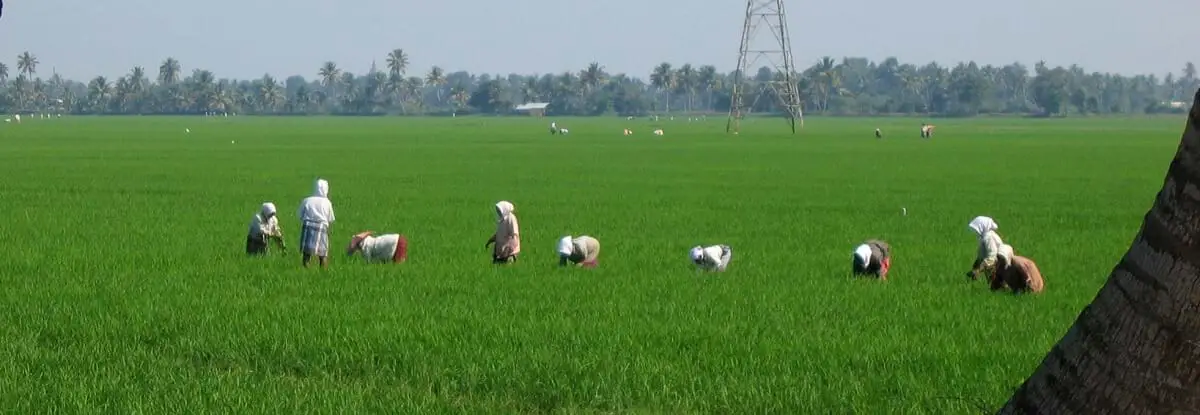Primitive Subsistence Agriculture Guide
Primitive Subsistence Farming

Primitive subsistence farming is considered the oldest form of agriculture and is still in use in some regions worldwide.
Traditionally, primitive farming uses low technology and household labor to produce a small output of crops.
There are no chemicals, fertilizers, pesticides, or technology getting used by the farmers.
For primitive subsistence farming, you would only grow food for yourself and your family. However, a small surplus of crops sometimes gets sold to provide extra cash.
Examples of Primitive Subsistence Agriculture
Types of Primitive Subsistence Agriculture
- 1) Shifting Cultivation
- 2) Nomadic Herding
Shifting Cultivation
Define Primitive Subsistence Farming
For shifting cultivation, also known as slash and burn agriculture, land areas get cleared with the plant matter, and the plant matter gets burned on the plot.
The size of the land areas is relatively small. They are usually around 1 to 3 acres large.
The practice gets used in areas with heavy rainfall and quick regeneration of vegetation.
It gets primarily used in the Amazon basin, tropical Africa, parts of Southeast Asia, and Northeast India.
Once the soil losses its fertility, it gets abandoned, with the farmer moving to a new plot of land and repeating the process.
Shifting agriculture is one of the most wasteful in human energy because of the amount of manual labor needed.
Farmers will stagger the planting of their crops to provide food to their families all year long. As a result, all the farms in an area will generally be planting the same crops.
Nomadic Herding
Nomadic herding is the second type of primitive agriculture manly getting used in Sahara, Central Asia, and India.
Nomadic herding focuses on herders moving from place to place with their animals to provide water and fodder, usually along defined routes.
Common animals of nomadic herding are sheep, camel, yak, and goats. The herders will collect milk, meat wool, and hides from their livestock for themselves and their families.
Nomadic herders are different from subsistence farmers since many of them do get paid through wages. They will herd other people's animals for a fee.
Many others sell their herds and materials for good and services.
Pros and Cons of Primitive Subsistence Farming
Advantages of Primitive Subsistence Farming
- 1) It is Cheaper No large investments are needed. From the land to many of the tools are not paid for by the farmers.
- 2) No Hiring of Labor The labor involves in these farms uses their families. No outside workers get hired for the production of crops.
- 3) A Ready Source of Employment Because of the basic tools in use, the methods can get taught to anyone very quickly. There is no need for schooling to open up the technique to almost anyone.
- 4) Source of Food Supply for the Family The main advantage can feed your family while living in such remote areas.
- 5) Do Not Use Monocultures Multiple crop types get planted together, helping to keep the land's biodiversity.
Disadvantages of Primitive Subsistence Farming
- 1) Few Crop Types Farmers are limited to the different species of crops that they can grow.
- 2) Dependent on Rainfall Because of the location and most farmers who perform this method are pretty poor, and irrigation is not an option.
- 3) Farm Size Restraints Since all labor gets done by hand, and farms get kept rather small to get adequately managed.
- 4) Generally Produces Just Enough Produce Because of the lack of available resources like fertilizers and no use of automation equipment, the farms cannot maximize production.
- 5) Small Yields A low production level and the lack of fertilizers to maximize crop growth result in small yields for the farmer.
- 6) Participates in Deforestation Areas are cleared and burned to make the available farmland. Once the soil is no longer fertile farmers, move to the next open land area and cut down and burn the vegetation of the next site.
Crops Grown in Primitive Subsistence Farming
Farmers who perform primitive subsistence farming focus their time on more starchy food crops.
We would plant the most common crops: tapioca, cassava or cassava, yams, corn or maize, millet, mountain rice, beans, potatoes, and bananas.
Disadvantages of Primitive Subsistence Farming
Farmers who perform primitive subsistence farming focus their time on more starchy food crops.
The most common crops getting planted: tapioca, cassava or cassava, yams, corn or maize, millet, mountain rice, beans, potatoes, and bananas.
Primitive Subsistence Farming Tools
- 1) Dao
- 2) Hoe
- 3) Digging Sticks
- 4) Family or Community Labor
The tools are basic and do not use any types of machinery developed for agriculture.
Conclusion
Primitive Subsistence Farming is the original method we used to gather crops.
With all the advances made in agriculture, it is also one of the least efficient methods today.
Very few places still use this as a primary way to produce crops for their country.
Similar Articles
Intercropping and Crop Rotation
Impact of Monoculture on Food Security
Advantages And Disadvantages of Intensive Farming